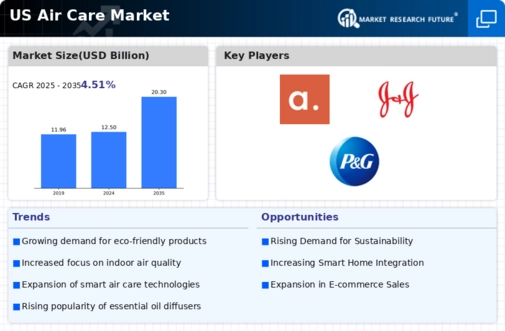The air care market in the US is characterized by a dynamic competitive landscape, driven by innovation, sustainability, and evolving consumer preferences. Major players such as Procter & Gamble (US), SC Johnson (US), and Reckitt Benckiser (GB) are actively shaping the market through strategic initiatives. Procter & Gamble (US) focuses on product innovation and sustainability, aiming to reduce its carbon footprint while enhancing product efficacy. SC Johnson (US) emphasizes eco-friendly formulations and packaging, aligning with consumer demand for sustainable products. Reckitt Benckiser (GB) leverages its strong brand portfolio to introduce new air care solutions that cater to diverse consumer needs, thereby enhancing its market presence. Collectively, these strategies foster a competitive environment that prioritizes sustainability and innovation, setting the stage for future growth.
Key business tactics within the air care market include localizing manufacturing and optimizing supply chains to enhance efficiency and responsiveness. The market structure appears moderately fragmented, with several key players holding substantial market shares. This fragmentation allows for a variety of product offerings, catering to different consumer segments. The collective influence of these major companies shapes market dynamics, as they compete not only on product quality but also on sustainability and innovation.
In October 2025, Procter & Gamble (US) announced the launch of a new line of air fresheners made from 100% recycled materials. This strategic move underscores the company's commitment to sustainability and positions it favorably among environmentally conscious consumers. By utilizing recycled materials, Procter & Gamble (US) not only addresses consumer preferences but also enhances its brand image as a leader in sustainable practices within the air care sector.
In September 2025, SC Johnson (US) unveiled a partnership with a leading technology firm to develop smart air care solutions that integrate with home automation systems. This initiative reflects SC Johnson's focus on digital transformation and innovation, aiming to provide consumers with enhanced control over their air quality. The integration of technology into air care products may significantly influence consumer purchasing decisions, as convenience and connectivity become increasingly important.
In August 2025, Reckitt Benckiser (GB) expanded its product line by introducing a new range of air care products specifically designed for pet owners. This strategic expansion targets a niche market segment, capitalizing on the growing trend of pet ownership in the US. By addressing the unique needs of pet owners, Reckitt Benckiser (GB) not only diversifies its product offerings but also strengthens its competitive position in the air care market.
As of November 2025, current trends in the air care market indicate a strong emphasis on digitalization, sustainability, and the integration of artificial intelligence in product development. Strategic alliances among key players are increasingly shaping the competitive landscape, fostering innovation and enhancing product offerings. Looking ahead, competitive differentiation is likely to evolve, with a shift from price-based competition to a focus on innovation, technology, and supply chain reliability. Companies that successfully navigate these trends will likely secure a competitive edge in the ever-evolving air care market.














Leave a Comment